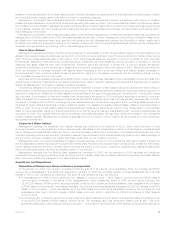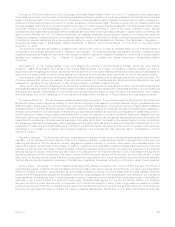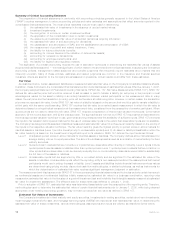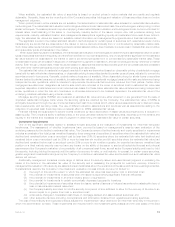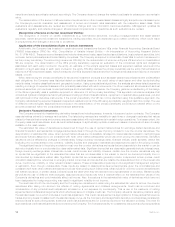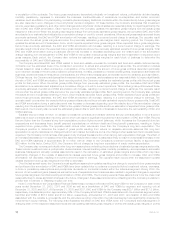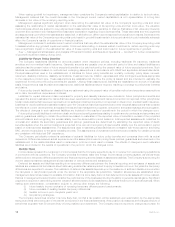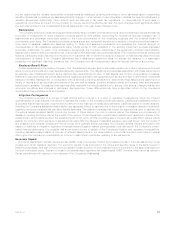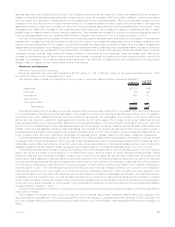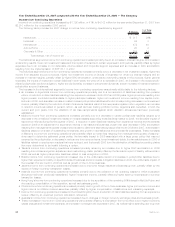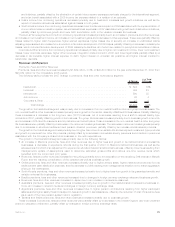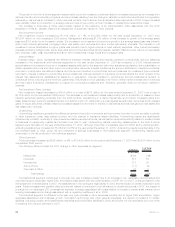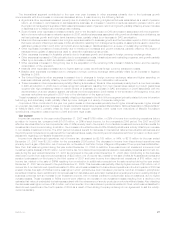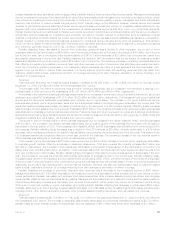MetLife 2008 Annual Report Download - page 22
Download and view the complete annual report
Please find page 22 of the 2008 MetLife annual report below. You can navigate through the pages in the report by either clicking on the pages listed below, or by using the keyword search tool below to find specific information within the annual report.income taxes when the ultimate deductibility of certain items is challenged by taxing authorities or when estimates used in determining
valuation allowances on deferred tax assets significantly change, or when receipt of new information indicates the need for adjustment in
valuation allowances. Additionally, future events, such as changes in tax laws, tax regulations, or interpretations of such laws or
regulations, could have an impact on the provision for income tax and the effective tax rate. Any such changes could significantly affect
the amounts reported in the consolidated financial statements in the year these changes occur.
Reinsurance
The Company enters into reinsurance agreements primarily as a purchaser of reinsurance for its various insurance products and also as
a provider of reinsurance for some insurance products issued by third parties. Accounting for reinsurance requires extensive use of
assumptions and estimates, particularly related to the future performance of the underlying business and the potential impact of
counterparty credit risks. The Company periodically reviews actual and anticipated experience compared to the aforementioned assump-
tions used to establish assets and liabilities relating to ceded and assumed reinsurance and evaluates the financial strength of
counterparties to its reinsurance agreements using criteria similar to that evaluated in the security impairment process discussed
previously. Additionally, for each of its reinsurance agreements, the Company determines if the agreement provides indemnification
against loss or liability relating to insurance risk, in accordance with applicable accounting standards. The Company reviews all contractual
features, particularly those that may limit the amount of insurance risk to which the reinsurer is subject or features that delay the timely
reimbursement of claims. If the Company determines that a reinsurance agreement does not expose the reinsurer to a reasonable
possibility of a significant loss from insurance risk, the Company records the agreement using the deposit method of accounting.
Employee Benefit Plans
Certain subsidiaries of the Holding Company (the “Subsidiaries”) sponsor and/or administer pension and other postretirement benefit
plans covering employees who meet specified eligibility requirements. The obligations and expenses associated with these plans require
an extensive use of assumptions such as the discount rate, expected rate of return on plan assets, rate of future compensation increases,
healthcare cost trend rates, as well as assumptions regarding participant demographics such as rate and age of retirements, withdrawal
rates and mortality. Management, in consultation with its external consulting actuarial firm, determines these assumptions based upon a
variety of factors such as historical performance of the plan and its assets, currently available market and industry data, and expected
benefit payout streams. The assumptions used may differ materially from actual results due to, among other factors, changing market and
economic conditions and changes in participant demographics. These differences may have a significant effect on the Company’s
consolidated financial statements and liquidity.
Litigation Contingencies
The Company is a party to a number of legal actions and is involved in a number of regulatory investigations. Given the inherent
unpredictability of these matters, it is difficult to estimate the impact on the Company’s financial position. Liabilities are established when it
is probable that a loss has been incurred and the amount of the loss can be reasonably estimated. Liabilities related to certain lawsuits,
including the Company’s asbestos-related liability, are especially difficult to estimate due to the limitation of available data and uncertainty
regarding numerous variables that can affect liability estimates. The data and variables that impact the assumptions used to estimate the
Company’s asbestos-related liability include the number of future claims, the cost to resolve claims, the disease mix and severity of
disease in pending and future claims, the impact of the number of new claims filed in a particular jurisdiction and variations in the law in the
jurisdictions in which claims are filed, the possible impact of tort reform efforts, the willingness of courts to allow plaintiffs to pursue claims
against the Company when exposure to asbestos took place after the dangers of asbestos exposure were well known, and the impact of
any possible future adverse verdicts and their amounts. On a quarterly and annual basis, the Company reviews relevant information with
respect to liabilities for litigation, regulatory investigations and litigation-related contingencies to be reflected in the Company’s consol-
idated financial statements. It is possible that an adverse outcome in certain of the Company’s litigation and regulatory investigations,
including asbestos-related cases, or the use of different assumptions in the determination of amounts recorded could have a material
effect upon the Company’s consolidated net income or cash flows in particular quarterly or annual periods.
Economic Capital
Economic capital is an internally developed risk capital model, the purpose of which is to measure the risk in the business and to provide
a basis upon which capital is deployed. The economic capital model accounts for the unique and specific nature of the risks inherent in
MetLife’s businesses. As a part of the economic capital process, a portion of net investment income is credited to the segments based on
the level of allocated equity. This is in contrast to the standardized regulatory risk-based capital (“RBC”) formula, which is not as refined in
its risk calculations with respect to the nuances of the Company’s businesses.
19MetLife, Inc.


